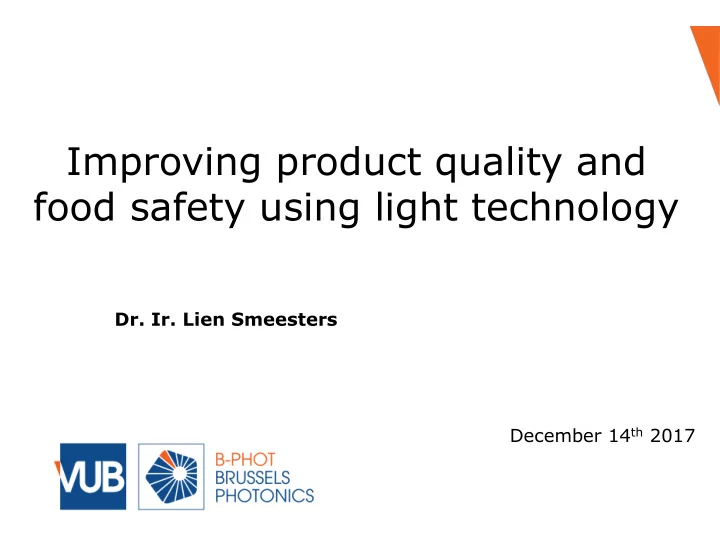

Improving product quality and food safety using light technology Dr. Ir. Lien Smeesters December 14 th 2017
Photonics for food industry Study of light and light-based technologies Optical spectroscopy 2
Photonics in food safety applications Authenticity tests – food fraud detection Evaluation of Detection of foreign Detection of carcinogens product quality objects 3
From non-destructive spectroscopic sensing to industrial implementation Internal scattering Absorption spectroscopy Fundamental spectroscopic study Integration in prototype One – and two – photon induced fluorescence Industrial implementation 4
From non-destructive spectroscopic sensing to industrial implementation Fundamental spectroscopic study Integration in prototype microfluidic lab-on-a-chip Industrial implementation 5
Outline: use of optical spectroscopy to improve food quality and food safety Identification of Belgian beers • Inspection of sealing of food packages • Strawberry ripeness determination • Prediction of acrylamide formation during frying • Detection of mycotoxins in food products • 6
Identification of Belgian beers using diffuse light absorption spectroscopy Most widely consumed alcoholic beverage • Differentiate between different beer varieties • Mignani, A.G., et. al., "Optical measurements and pattern-recognition techniques for identifying the characteristics of beer 7 and distinguishing Belgian beers”, Sensor and Actuators B 179, 140 -149 (2013).
Inspection of sealing of food packages using absorption spectroscopy Sealing inspection Eg. detection of cheese residues in sealing Use UV-VIS-NIR absorption spectroscopy 8
Strawberry ripeness determination for automated picking class1 class 5 Categorization of strawberries using spectroscopy 9
Optical spectroscopy to improve food safety: prediction of acrylamide formation during frying T T Starch Reducing sugars Water French fries guideline* Asparagine Acrylamide 600 ppb
Optical spectroscopy to improve food safety: prediction of acrylamide formation during frying 200 – 240 ppb Acrylamide Fresh potato Fridge-stored 600 – 2000 ppb potato (4°C) Acrylamide EU-guideline: 600 ppb Smeesters et al., patent EP16157211.0 Smeesters, L., et. al., “Internal scattering as an optical screening method to identify peeled potatoes giving rise to an 11 excess of acrylamide”, Journal of Food Engineering (195), 225 -261 (2017).
Optical spectroscopy to improve food safety: mycotoxin detection using fluorescence spectroscopy Mycotoxins legal limit Aflatoxins (AFLA) 4 - 15 ppb Ochratoxin A (OCHRA A) 5 ppb Zearalenone (ZEA) 100 - 350 ppb Deoxynivalenol (DON) 1250 - 1750 ppb Fumonisins (FUM) 4000 ppb 12
General conclusion Successful application of spectroscopic methodologies for food industry Food quality • Food fraud • Food safety • Optical spectroscopy ✓ Non-destructive method Accurate in-line detection ✓ Individual solid food products ✓ Global legislations ✓ Industrial POC demonstrator ✓ 13
General conclusion Contribution to an increased food safety of millions of families. 14
Recommend
More recommend